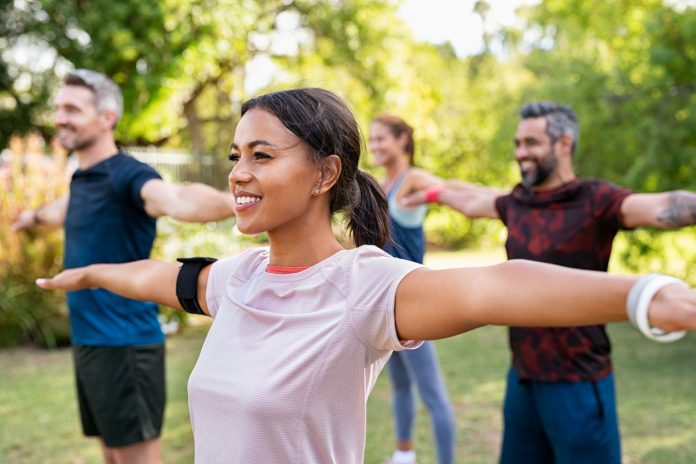We discuss the impact of exercise on mental health and wellbeing with representatives of the American Psychological Association’s Division 47
The mental health benefits that can be derived from exercise are well documented, and it is often prescribed as a remedy for those experiencing poor mental health. To discuss the mechanisms behind the brain and body connection, Open Access Government spoke to Jaclyn P. Maher, Brynn L. Hudgins, and Michael L. Sachs on behalf of the American Psychological Association’s Division 47. Division 47 aims to advance sport, exercise, and performance psychology by bringing together psychologists and exercise and sport scientists who are interested in research, teaching, and service in this area.
Can you briefly describe what happens in our brains when we exercise? How do such mechanisms support brain health and mental wellbeing?
When we exercise, physical changes in our brain and bodies occur that support improvements in brain health and wellbeing. Regular exercise can result in structural and functional changes in the brain, such as the generation of new neurons in the hippocampus. The hippocampus is a part of our brain involved in learning and memory. It is also implicated in mood regulation and stress response (individuals with depression tend to have a reduction in the volume of the hippocampus). Additionally, chemical changes occur within the brain in response to exercise. Exercise stimulates the release of neurotransmitters (i.e., chemicals that allow neurons in our body to communicate with one another), like dopamine, serotonin, and norepinephrine. These neurotransmitters can help to regulate our moods, control our stress response, and generally impact our overall emotional health. Relatedly, exercise increases the production of brain-derived neurotrophic factors.
Brain-derived neurotrophic factor is a protein that supports the growth, survival, and maintenance of neurons and is particularly important for the health of the hippocampus. Another way in which regular exercise can improve our brain health and wellbeing is through the effect of exercise on inflammation. Exercise has been shown to have anti-inflammatory effects, and individuals with mental health disorders like anxiety and depression tend to have elevated levels of inflammatory markers. Exercise can help reduce chronic or excessive inflammation that can negatively impact mental health.
Exercise can also help regulate the body’s stress response by lowering cortisol levels (the stress hormone). Likewise, exercise can promote resilience when individuals face stressors. Finally, a more relaxed state of mind can promote better sleep. Regular exercise can improve sleep quality, which is crucial for mental health and wellbeing.
In addition to these physical changes, psychological changes occur due to exercise that can improve our mental health and wellbeing. Exercise can help individuals view themselves more positively, feeling more confident and capable in their daily lives. These positive changes in our self-perceptions ultimately contribute to people feeling more worthy and valuable as human beings, which enhances our health and sense of wellbeing. Additionally, engaging in activity, whether through a more structured social setting like an exercise class or something more informal like seeing people walking at the park, creates opportunities for social interaction, emotional discourse, and new social networks. These experiences enhance perceptions of social support, and we begin to feel we have others to turn to in times of need. All of these elements improve our mental health and wellbeing.
Can you tell me about the type(s) of exercise and duration necessary to derive mental health benefits?
Many types of exercise can provide mental health benefits. Aerobic exercise, such as walking, swimming, cycling, and dancing, can improve mental health by increasing heart rate and blood flow, releasing hormones that help to reduce stress. Yoga and tai-chai are also great options focusing on the mind-body connection to promote relaxation and preserve and maintain mental health. Strength training activities such as lifting weights, working with resistance bands, or doing exercises that use your body weight for resistance (e.g., push-ups, sit-ups) can positively impact hormone and neurotransmitter regulation and improve sleep quality, impacting mental health and wellbeing.
There is evidence that exercising with a friend or family member in a social context can produce mental health benefits due to providing a sense of connectedness and belonging. Furthermore, exercising outside near greenery or water can improve mood because being surrounded by nature can bring about calm and peace.
According to the 2018 Physical Activity Guidelines for Americans, engaging in at least 150 minutes (two and a half hours) and up to 300 minutes (five hours) per week of aerobic exercise and strength training activities involving all major muscle groups on at least two days per week is recommended to obtain health benefits. Exercise can be broken up into sessions of shorter duration, and acute benefits can even be seen from as little as ten-minute bouts. However, the most important aspect when seeking mental health benefits from exercise is to exercise regularly. This is best accomplished by choosing the type of exercise that you most enjoy and will stick with. Overall, exercise is a great way to promote mental health and should be tailored to the individual to produce the best results possible.
What types of mental health conditions could be supported through regular exercise? Equally, what are the barriers to exercise for people suffering from poor mental health, and how could these be addressed?
There are numerous mental health conditions for which exercise may prove beneficial. At the top of the list are depression and anxiety, about which there is an extensive set of research literature. Additionally, there are more popular works that address the beneficial effects of exercise on depression, exceptionally mild to moderate levels of depression – the jury is still out on the impact of severe depression. Similarly, the anxiolytic effects of exercise on anxiety are well documented. Exercise has also been shown to be effective with some phobias, such as agoraphobia. Other mental health conditions may be helped by exercise in conjunction with psychotherapy, including obsessive-compulsive behavior as well as eating disorders.
It is critical to note that these effects of exercise are individual, and no one size – including frequency, duration, intensity, type – will fit all individuals. Indeed, some clients/patients may not be receptive to exercise, especially those who are sedentary. Client/patient buy-in is extremely important in this process.
Key barriers to success include sedentariness and/or lack of desire for any form of activity, which can be characteristic of cases of severe depression. Engaging in regular exercise is of little to no interest to a considerable percentage of the American population (as one can note in CDC statistics of obesity as well as physical activity), and this includes many with poor mental health. There are a variety of behavior change strategies available to assist individuals in moving from sedentariness to active engagement in exercise and then adherence or maintenance of regular exercise for the long term. The 2018 Physical Activity Guidelines for Americans outlines evidence- based strategies for helping people to become more physically active, these strategies include evidence-based steps individuals as well as communities can take to promote physical activity.
Older adults are particularly vulnerable to poor mental health; what could be done to stimulate behavioral change in people early on in life so they see the benefits of exercise?
First, it is important to note that it is never too late to become more physically active. Although exercise is considered a more intentional form of physical activity for health benefits, any bodily movement is considered physical activity, and the more physical activity we can integrate into our daily lives, the better. The US Federal Physical Activity Guidelines note that some physical activity is better than none, and individuals often experience the most significant health improvements when they go from engaging in no physical activity to some, even if they are not meeting the physical activity guidelines. Ideally, physical activity would encompass activities focusing on cardiovascular fitness and strength training. If you are unsure how to begin (or how to add strength training to your exercise activity), see a professional – a certified personal trainer can help develop an exercise program that works for you!
Second, one of the keys to becoming a lifelong engager in physical activity is discovering what types of physical activity you enjoy. We are more likely to stick with behaviors that we find pleasant and enjoyable, so the best bet for making physical activity a lifelong habit is to take time to discover ways to move your body that bring you joy.
Third, find a support system. This could be a person or group of people you exercise with or people who encourage you to be active, provide relevant information, and/or provide tangible assistance to help support your activities. When individuals experience this kind of support for physical activity, they are more likely to engage in physical activity and sustain that behavior long-term. Especially as we grow older or become more chronologically gifted, as we like to say, social support often becomes that much more important. Find people you enjoy spending time with, exercise together, and have fun!
How does Division 47 work with other organizations like the National Institutes of Health (NIH) to support exercise and sports psychology research?
Although the American Psychological Association’s (APA) Division 47 does not currently have a relationship with organizations like NIH to support research, APA, as a larger organizational body, does. Through the annual APA Convention and the Division’s peer-reviewed scientific journal (Sport, Exercise, and Performance Psychology), we provide opportunities for members to publish their research as well as offer several annual awards to promote and honor distinguished contributions to the field and through selecting a Paper of the Year based on innovative and rigorous research among other criteria. Division 47’s values and initiatives encompass supporting the dissemination of research findings, promoting best practices in sport, exercise, and performance psychology, and providing resources to the public.
Jaclyn P. Maher, Ph.D.
Brynn L. Hudgins, M.S.
Michael L. Sachs, Ph.D., CMPC
Website
Twitter
LinkedIn
Facebook











